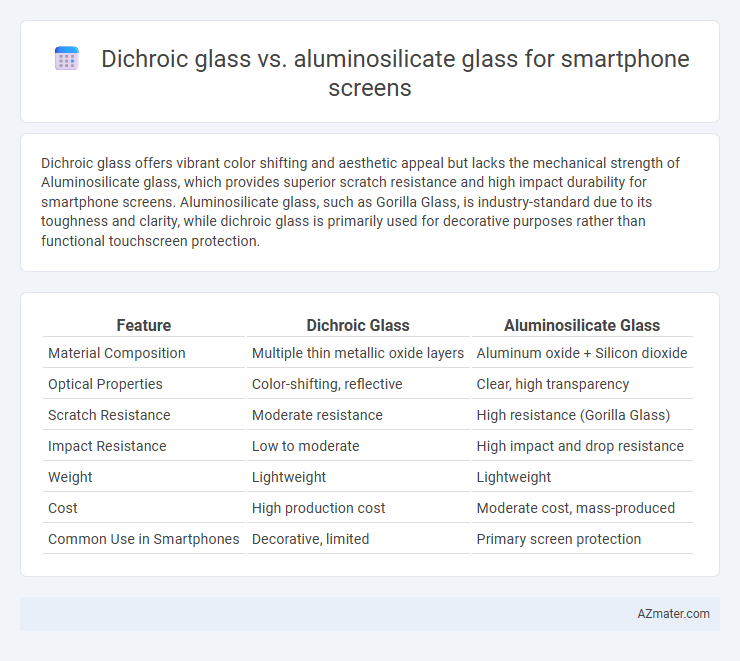Dichroic glass offers vibrant color shifting and aesthetic appeal but lacks the mechanical strength of Aluminosilicate glass, which provides superior scratch resistance and high impact durability for smartphone screens. Aluminosilicate glass, such as Gorilla Glass, is industry-standard due to its toughness and clarity, while dichroic glass is primarily used for decorative purposes rather than functional touchscreen protection.
Table of Comparison
| Feature | Dichroic Glass | Aluminosilicate Glass |
|---|---|---|
| Material Composition | Multiple thin metallic oxide layers | Aluminum oxide + Silicon dioxide |
| Optical Properties | Color-shifting, reflective | Clear, high transparency |
| Scratch Resistance | Moderate resistance | High resistance (Gorilla Glass) |
| Impact Resistance | Low to moderate | High impact and drop resistance |
| Weight | Lightweight | Lightweight |
| Cost | High production cost | Moderate cost, mass-produced |
| Common Use in Smartphones | Decorative, limited | Primary screen protection |
Introduction to Smartphone Screen Glass Types
Dichroic glass and aluminosilicate glass represent two distinct materials used in smartphone screens, with aluminosilicate glass commonly favored for its superior durability and scratch resistance due to its chemical strengthening process. Dichroic glass, known for its unique optical properties and color-shifting effects, is less prevalent in phone displays but may offer innovative visual aesthetics. Aluminosilicate glass, often branded as Gorilla Glass, provides an optimal balance of hardness and flexibility, making it the industry standard for protecting smartphone screens against impact and everyday wear.
What is Dichroic Glass?
Dichroic glass is a type of glass that displays multiple colors by selectively reflecting and transmitting light through thin layers of metal oxides deposited on its surface, making it primarily used for decorative and artistic purposes rather than functional smartphone screens. Aluminosilicate glass, such as Gorilla Glass, is engineered for high durability, scratch resistance, and impact protection, making it the preferred material for smartphone screens. Unlike aluminosilicate glass, dichroic glass lacks the strength and clarity requirements needed for effective smartphone display protection.
What is Aluminosilicate Glass?
Aluminosilicate glass is a durable, high-strength material used extensively in smartphone screens due to its enhanced scratch resistance and impact durability compared to conventional glass types. It is composed primarily of aluminum oxide (alumina) and silica, providing improved thermal stability and chemical resistance ideal for daily smartphone use. Compared to dichroic glass, which is prized for its optical properties and color effects, aluminosilicate glass prioritizes structural protection and longevity in touchscreen devices.
Key Material Properties Compared
Dichroic glass exhibits unique optical properties with its multi-layer coatings that create vibrant color shifts but lacks the mechanical strength and scratch resistance essential for smartphone screens. Aluminosilicate glass offers superior hardness, chemical durability, and impact resistance due to its alumina content, making it the preferred choice for smartphone displays. Its high fracture toughness and oleophobic coating capabilities enhance touchscreen longevity and user experience compared to the decorative yet fragile dichroic glass.
Strength and Durability Differences
Aluminosilicate glass, commonly used in smartphone screens, offers superior strength and scratch resistance compared to Dichroic glass due to its chemically strengthened composition that withstands impacts and flexural stress effectively. Dichroic glass, known for its unique optical properties and multi-layer coating, lacks the robust structural integrity required for everyday smartphone durability and is more prone to chipping or cracking under physical stress. Therefore, Aluminosilicate glass is preferred for smartphone screens where enhanced toughness and long-term durability are critical performance factors.
Optical Clarity and Color Performance
Dichroic glass offers superior optical clarity by selectively reflecting and transmitting specific wavelengths, producing vibrant color shifts that enhance visual depth and color performance on smartphone screens. Aluminosilicate glass, known for its high scratch resistance and durability, provides consistent transparency with minimal color distortion but lacks the dynamic color-shifting properties inherent to dichroic materials. When prioritizing enhanced visual aesthetics with vivid, shifting colors, dichroic glass excels, while aluminosilicate glass remains optimal for robust, clear, and true-to-life display clarity.
Scratch and Impact Resistance
Dichroic glass offers a unique optical effect with moderate scratch resistance but generally falls short in impact resistance compared to aluminosilicate glass. Aluminosilicate glass, widely used in smartphone screens, provides superior toughness and enhanced resistance to both scratches and drops due to its chemically strengthened composition. Its high hardness rating and ability to absorb impact energy make it the preferred choice for durable, protective smartphone displays.
Cost Implications and Manufacturing
Dichroic glass involves complex thin-film coatings that significantly increase production costs compared to aluminosilicate glass, which is favored for its affordability and durability in smartphone screens. Manufacturing dichroic glass requires precision layering and optical control, leading to higher labor and equipment expenses, whereas aluminosilicate glass benefits from streamlined ion-exchange strengthening processes that scale efficiently. The cost implications make aluminosilicate glass the predominant choice in mass-market devices, while dichroic glass remains niche and experimental due to its premium pricing.
User Experience and Real-World Usage
Dichroic glass on smartphone screens enhances visual appeal through its unique color-shifting properties but may reduce clarity and increase glare under direct sunlight, impacting user experience negatively in bright environments. Aluminosilicate glass, commonly used in smartphones like Gorilla Glass, prioritizes scratch resistance, durability, and touch sensitivity, providing a reliable and clear display for everyday usage. Real-world usage favors aluminosilicate glass due to its balance of toughness and optical clarity, ensuring long-term screen protection and consistent user interaction.
Choosing the Best Glass for Smartphones
Dichroic glass offers vibrant color shifts and aesthetic appeal but lacks the durability and scratch resistance required for smartphone screens. Aluminosilicate glass, commonly used in Gorilla Glass, provides superior hardness, impact resistance, and chemical stability, making it ideal for daily smartphone use. Choosing aluminosilicate glass ensures enhanced screen protection and longer device lifespan compared to the decorative but fragile dichroic glass.

Infographic: Dichroic glass vs Aluminosilicate glass for Smartphone screen
 azmater.com
azmater.com